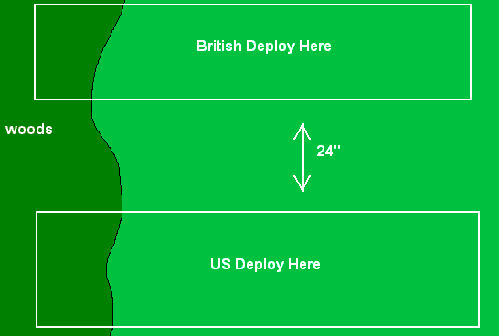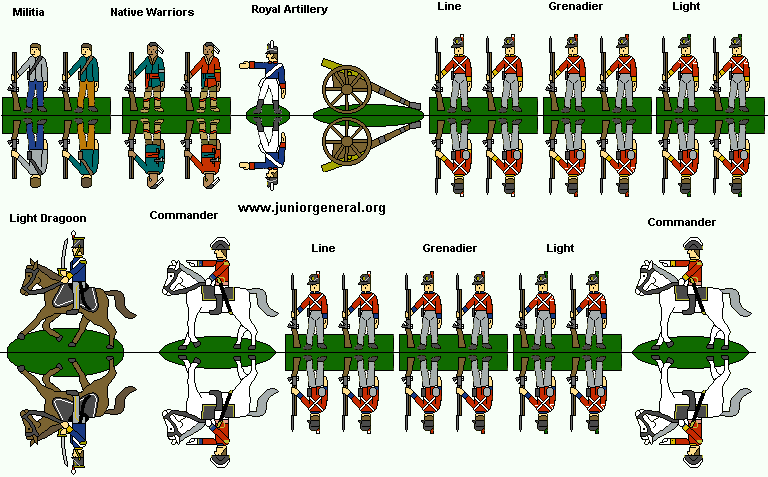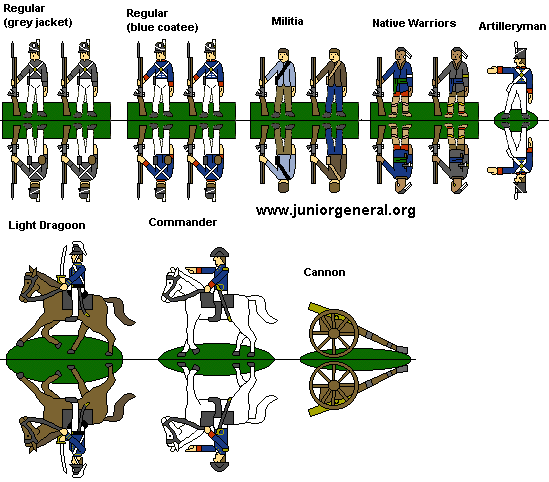 Historical Background:
Historical Background:
The War of 1812 has been nearly forgotten in the US. Few Americans realize the "Star-Spangled Banner" is about the War of 1812. The declaration of war was controversial at the time, and the war ended as a stalemate, resolving none of the issues that started it. Several attempts to invade Canada ended in failure. While American privateers harassed British shipping, the Royal Navy blockaded the East Coast. In 1814 the British marched on Washington DC and set the White House on fire. The US won important naval battles on Lake Erie and Lake Champlain, saving the country from a costly defeat. The most famous battle, Andrew Jackson's victory at New Orleans, was fought after the peace treaty was signed ending the war.
The battle of Chippawa (1814) was a landmark victory for the US army, marking the first time it defeated the veteran British regulars in open combat. When Winfield Scott's grey jacketed 1st Brigade was first seen the British may have mistaken them for militia. Watching them under fire, however, it became obvious that they were in fact well trained regulars. The US and British lines faced each other at close range, exchanging musket and cannon fire. After both sides suffered terrible casualties it was the British that withdrew.
Battle 1: This battle has not yet been playtested.
Building the Armies: Right now there aren't any 1/72 plastic soldiers designed for the War of 1812 but Imex should be releasing some soon. British infantry and artillery from one of the Napoleonic sets could be used for regulars and artillerymen on both sides. Some figures suitable for militia can be found in the Imex Alamo Defenders set. Hat's Napoleonic KGL Light Dragoons could be used for the British dragoons, and Italeri's Napoleonic French Dragoons could pass for the US dragoons (cut the knob off the helmet crest). I don't like any of the available native warrior sets. I suppose you could pick a few of the better poses from Revell's Indians, or Imex's Sioux Indians. Some paper soldiers are included which you can print and use. Infantry and cavalry are mounted two per base. Cavalry bases are 1.5" square, infantry bases are 3/4" x 1.5". Commanders are based singly on 3/4" x 1.5" bases.
The Map: The battle was played on a 5' x 7.5' table. The battlefield is open and flat terrain except for the woods in the west. The woods can be drawn in marker, marked by a piece of green felt, or represented however you choose.
Deployment: The US and British deploy as shown on the map. Only Militia, Native Warriors, and British Light Infantry may start in the woods.
Orders of Battle: All units have six bases. The British organization has been changed to create additional commands. The 1st, 8th, and 100th Foot were brigaded together under Gen. Riall. Winfield Scott has been listed as overall commander for the US, although this position was held by Major General Jacob Brown. Scott was the commander on the battlefield, and largely responsible for the victory, and so I've given him credit.
- British
- Maj. Gen. Phineas Riall (Overall Commander)
1 unit Grenadiers
1 unit Light Dragoons (19th Light Dragoons)
1 Cannon
1st Foot, Royal Scots - Lt. Col. John Gordon
3 units Line Infantry
1 Cannon
8th Foot, King's Regiment - Major Thomas Evans
3 units Line Infantry
1 Cannon
100th Foot - Lt. Col George Hay
3 units Line Infantry
1 Cannon
2nd Brigade - Col. Pearson
1 unit Light Infantry
2 units Canadian Militia (2nd Lincoln)
2 units Native Warriors (Western & Grand River Indians)
United States
- Brig. Gen. Winfield Scott (Overall Commander)
1 unit US Light Dragoons
2 Cannons
9th/22nd Infantry - Maj. Henry Leavenworth
4 units Regular Infantry
1 Cannon
11th Infantry - Maj. John McNeil
4 units Regular Infantry
1 Cannon
25th Infantry - Maj. Thomas Jesup
4 units Regular Infantry
1 Cannon
3rd Brigade- Brig. Gen. Peter Porter
2 units Militia (Pennsylvania Volunteer Infantry)
2 units Native Warriors (Seneca, Oneida, Cayuga Indians)


Why, These are Regulars! Battle of Chippawa (1814)
Back to Table of Contents -- Junior General Report # 5
Back to Junior General Report List of Issues
Back to MagWeb.com Magazine List
© Copyright 2004 by Matt Fritz.
This article appears in MagWeb.com (Magazine Web) on the Internet World Wide Web. Other articles covering military history and related topics are available at http://www.magweb.com